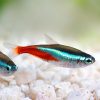Address
Center: Georgiou Theochari 4 Thessaloniki 54621
Kalamaria: Georgiou Papandreou 17A Thessaloniki 54645
Opening hours
Monday - Friday: 9am - 7pm
Saturday: 9am - 2:30pm
Address
Center: Georgiou Theochari 4 Thessaloniki 54621
Kalamaria: Georgiou Papandreou 17A Thessaloniki 54645
Opening hours
Monday - Friday: 9am - 7pm
Saturday: 9am - 2:30pm






Description
Scientific Name: Paracheirodon innesi (Myers, 1936)
Common Names: Neon Tetra
Greek Name: Neon Tetra
General Category: Characins
Order: Characiformes
Family: Characidae
Size: 3 - 3,5 cm.
Habitat: Neon tetra are native to western Brazil, southeastern Colombia and eastern Peru, and in the wild can also be found in the Amazon, Tigris, Napo and Yarapa rivers. They can be found in both blackwater (blackwater) and clearwater (clearwater) streams. They have not, however, been found in whitewater (whitewater) tributaries descending from the Andes.
The blackwater and Clearwater rivers of South America have very soft and quite acidic water. The water temperature in these tropical areas is in the 20-26°C range, sometimes a little higher.
Their natural habitat in South America is densely vegetated with enough low-light areas to hide from predators.
Maintenance in the aquarium
PH: 5-7 (Ideal: 6)
KH: –
GH: 2-10°dGH (Ideal: 5-7°dGH)
Temperature: 20-27°C (Ideal: 24°C)
Liters: A school of 8-10 Neon fish can be kept in an 80 litre tank provided that they are the only fish that circulate in the middle and upper part of the water. They can be accompanied by 6-8 small size bottom catfish.
Ideally this fish should be kept in a 100+ litre tank.
Social Behavior: Friendly tetra, ideal for a social aquarium for small fish.
Gender separation: Adult females are larger than males. Also in females the belly area is more rounded and the blue line is not as straight as it is in males. The line issue, in females, can be affected by whether the female is an egg carrier or not.
Aquarium decoration: Medium to low filter flow. White sand, wood and a few easy plants since the aquarium lighting should be relatively low. However, it can also be maintained in tanks with more intense lighting provided there are more plants so that the fish has plenty of escape points when it feels in danger. It is almost essential that humic acids and tannins are present either as an addition to commercial preparations or from natural sources such as wood from long-lived forests.
Swimming Zone: Mainly in the middle of the aquarium.
Food: Neon tetra are classified as omnivores, they will eat any food in flakes, but it would be good to enrich their diet with daphnia, bloodworms and brine shrimps.
Maximum age in the aquarium: 10 years in the wild, 5-8 years in aquariums in ideal conditions.
Ideal Roommates: They can cohabit with all moderately sized social fish of similar water chemistry conditions, and generally peaceful fish. In small aquariums they should be the only species of snapper that swims in the same zone. In addition if we can add a group of 6-8 small catfish provided a good filter. It should also be mentioned that neon are not suitable for cohabitation in tanks with scalars since they usually become their food. They are equally incompatible for aquariums with trays, since these aquariums occasionally need the temperature to rise above 30-32°C.
Subspecies and hybrids: Long fin neon tetra, Diamond neon tetra, Gold neon tetra.
Breeding in the aquarium: Quite a difficult fish to breed in the aquarium. It needs soft and very clean water. The breeding tank should be placed in a dark spot, as the eggs are sensitive to light, and be well planted.
General information: A highly commercial fish due to its beautiful colours and relatively low cost. However, it is very demanding in its living conditions as it is highly susceptible to diseases such as Ich (Ich) which can affect the other fish in the aquarium. Their true colours and behaviour will only come out in ideal conditions. As with all schooling fish, the larger the school, the more intensely they school, the more intensely they school.
Since most neon are not from breeding but are wild caught we have to pay special attention to the water quality, which must partly meet the actual water conditions that exist in nature. These particular water requirements they have are quite different from the water values in most areas of Greece and this makes them a not so easy fish for the aquarium of a beginner hobbyist.
It was also observed that fish that were kept in hard water over time developed kidney problems, causing the fish to become weak and vulnerable to disease, and over time, premature death. And finally a large proportion of fish bring from nature several pathogenic organisms such as Plistophora, Ichthyophtirius multifiliis, various fungi and bacteria.
| Weight | 1.5 kg |
|---|---|
| Manufacturer | Singapore |
Only logged in customers who have purchased this product may leave a review.
Reviews
There are no reviews yet